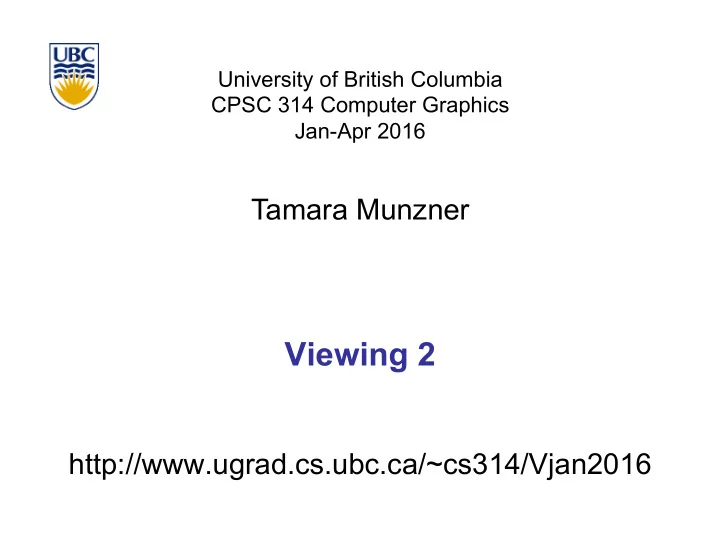

University of British Columbia CPSC 314 Computer Graphics Jan-Apr 2016 Tamara Munzner Viewing 2 http://www.ugrad.cs.ubc.ca/~cs314/Vjan2016
Projections I 2
Pinhole Camera • ingredients • box, film, hole punch • result • picture www.kodak.com www.pinhole.org www.debevec.org/Pinhole 3
Pinhole Camera • theoretical perfect pinhole • light shining through tiny hole into dark space yields upside-down picture one ray of projection perfect pinhole film plane 4
Pinhole Camera • non-zero sized hole • blur: rays hit multiple points on film plane multiple rays of projection actual pinhole film plane 5
Real Cameras • pinhole camera has small aperture (lens opening) • minimize blur aperture • problem: hard to get enough light to expose the film • solution: lens • permits larger apertures • permits changing distance to film plane without actually moving it lens • cost: limited depth of field where image is depth in focus of field 6 http://en.wikipedia.org/wiki/Image:DOF-ShallowDepthofField.jpg
Graphics Cameras • real pinhole camera: image inverted eye point image plane n computer graphics camera: convenient equivalent eye point center of image projection plane 7
General Projection • image plane need not be perpendicular to view plane eye point image plane eye point image plane 8
Perspective Projection • our camera must model perspective 9
Perspective Projection • our camera must model perspective 10
Projective Transformations • planar geometric projections • planar: onto a plane • geometric: using straight lines • projections: 3D -> 2D • aka projective mappings • counterexamples? 11
Projective Transformations • properties • lines mapped to lines and triangles to triangles • parallel lines do NOT remain parallel • e.g. rails vanishing at infinity • affine combinations are NOT preserved • e.g. center of a line does not map to center of projected line (perspective foreshortening) 12
Perspective Projection • project all geometry • through common center of projection (eye point) • onto an image plane x y -z z z x x 13
Perspective Projection projection plane center of projection (eye point) how tall should this bunny be? 14
Basic Perspective Projection similar triangles P(x,y,z) y P(x ’ ,y ’ ,z ’ ) z z ’ =d z ' = d but • nonuniform foreshortening • not affine 15
Perspective Projection • desired result for a point [x, y, z, 1] T projected onto the view plane: x ' x y ' y , = = d z d z x d x y d y ⋅ ⋅ x ' , y ' , z ' d = = = = = z z d z z d • what could a matrix look like to do this? 16
Simple Perspective Projection Matrix x z / d y z / d d 17
Simple Perspective Projection Matrix x x y z / d is homogenized version of z y z / d where w = z/d z / d d 18
Simple Perspective Projection Matrix x x y z / d is homogenized version of z y z / d where w = z/d z / d d x 1 0 0 0 x y 0 1 0 0 y = z 0 0 1 0 z z / d 0 0 1 d 0 1 19
Perspective Projection • expressible with 4x4 homogeneous matrix • use previously untouched bottom row • perspective projection is irreversible • many 3D points can be mapped to same (x, y, d) on the projection plane • no way to retrieve the unique z values 20
Moving COP to Infinity • as COP moves away, lines approach parallel • when COP at infinity, orthographic view 21
Orthographic Camera Projection • camera’s back plane x x parallel to lens p y y = • infinite focal length p z 0 • no perspective p convergence x 1 0 0 0 x p • just throw away z values y 0 1 0 0 y p = z 0 0 0 0 z p 1 0 0 0 1 1 22
Perspective to Orthographic • transformation of space • center of projection moves to infinity • view volume transformed • from frustum (truncated pyramid) to parallelepiped (box) x x Frustum Parallelepiped -z -z 23
View Volumes • specifies field-of-view, used for clipping • restricts domain of z stored for visibility test orthographic view volume perspective view volume y=top y=top x=left x=left y y z x=right z VCS z=-near x VCS y=bottom z=-far z=-far x y=bottom x=right z=-near 24
Asymmetric Frusta • our formulation allows asymmetry • why bother? x x right right Frustum Frustum -z -z left left z=-n z=-f 25
Asymmetric Frusta • our formulation allows asymmetry • why bother? binocular stereo • view vector not perpendicular to view plane Left Eye Right Eye 26
Simpler Formulation • left, right, bottom, top, near, far • nonintuitive • often overkill • look through window center • symmetric frustum • constraints • left = -right, bottom = -top 27
Field-of-View Formulation • FOV in one direction + aspect ratio (w/h) • determines FOV in other direction • also set near, far (reasonably intuitive) x w h fovx/2 Frustum -z α fovy/2 THREE.PerspectiveCamera (fovy,aspect,near,far); z=-n z=-f 28
Demos • frustum • http://webglfundamentals.org/webgl/frustum-diagram.html • http://www.ugrad.cs.ubc.ca/~cs314/Vsep2014/webGL/view- frustum.html • orthographic vs projection cameras • http://threejs.org/examples/#canvas_camera_orthographic2 • http://threejs.org/examples/#webgl_camera • https://www.script-tutorials.com/webgl-with-three-js-lesson-9/ 29
Recommend
More recommend